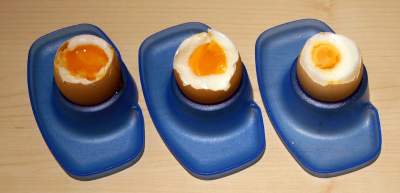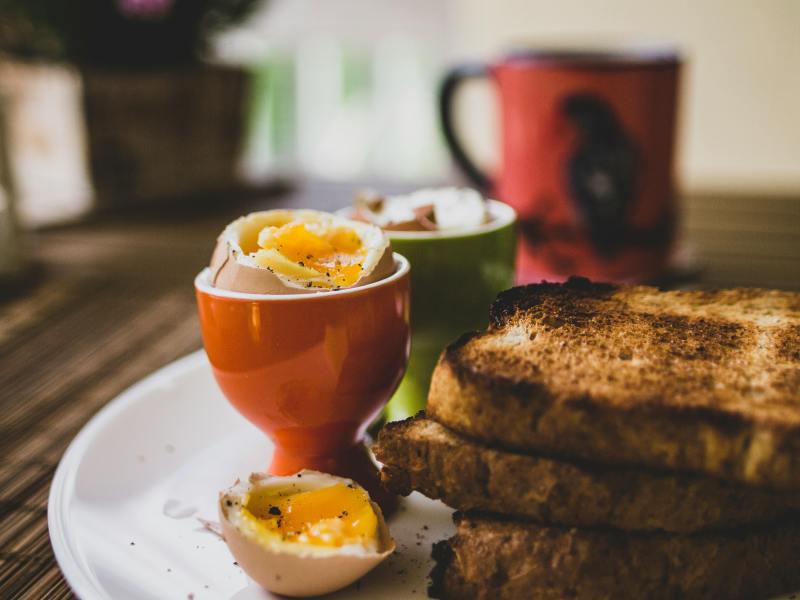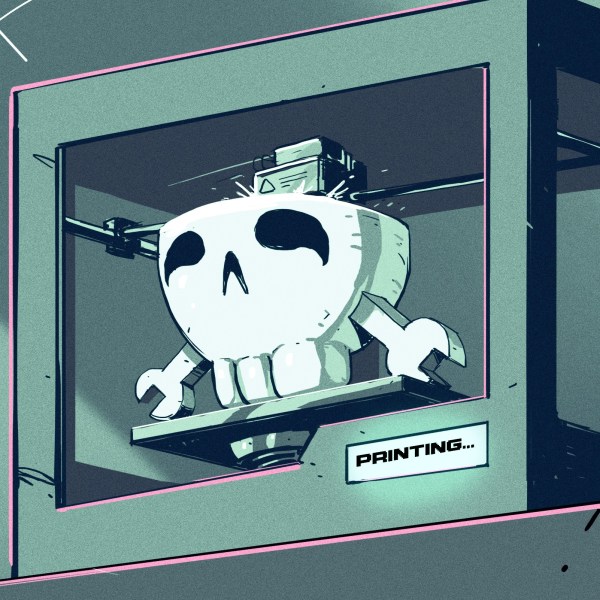Many of us have boiled an egg at some point or another in our lives. The conventional technique is relatively straightforward—get the water boiling, drop the egg in, and leave it for a certain period of time based on the desired consistency. If you want the yolk soft, only leave it in for a few minutes, and if you want it hard, go longer.
Ultimately, though, this is a relatively crude system for controlling the consistency of the final product. If you instead study the makeup of the egg, and understand how it works, you can elicit far greater control over the texture and behavior of your egg with great culinary benefits.
Knockin’ On 64

It all comes down to the physical basics of what goes on when we cook an egg. Whether frying, poaching, or simply boiling, one thing is the same—the liquid contents of the egg turn more solid with heat. This is because the heat causes the proteins in the egg white and egg yolk to denature—they untangle and unravel from their original folded structure into a new form which is the one we prefer to eat.
Physical chemist Hervé This is widely credited as revolutionizing the way we think about cooking eggs, through his careful study of how temperature affected the cooking process of a “boiled” egg. He invented the idea of the “6X °C egg”—a method of cooking eggs to generate a pleasant, smooth consistency by carefully controlling how the proteins denature. His work has since been expanded upon by many other researchers eager to untangle the mysteries of how egg proteins behave with heat.
Different purveyors of these theories each have their own ideals—but it’s common to hear talk of the “64-degree egg” or “65-degree egg.” To create such an egg, one typically uses a sous vide water bath set at a very precise temperature, in order to cook the egg in as controlled a manner as possible. The process is a relationship between time and temperature, and so the cooking times used are a lot longer than with boiling water at 100 C—immersing the eggs for 60 minutes or more is typical. This also helps to ensure the eggs are safe to eat, with the lower temperature needing a longer time to quash potentially harmful bacteria.
Enthusiasts share cooking times and temperatures along with qualitative results, ever searching for the ideal egg.
The results of such a process? Eggs cooked in this manner are prized for their tender yolks and an overall consistency not dissimilar to custard. The process denatures the yolk and white proteins just enough to create an incredibly smooth egg with luxurious mouthfeel, and they’re often cited as melting in the mouth.

The only real drawback? It’s typical to get some runny whites left over, since the low cooking temperature isn’t enough to fully denature the proteins in that part of the egg. These eggs were once a neat science experiment from the world of molecular gastronomy, with the cooking method since becoming widespread with restaurants and sous vide enthusiasts around the world.
There are even more advanced techniques for those committed to egg perfection. A research team from the University of Naples, Italy, determined that cycling an egg between two pans—one with boiling water, the other at 30 C—allowed both the yolk and the white to each reach target doneness. To get the whites to around 85 C while holding the yolk at 65 C, the team used the technique of swapping between pans to get both to their ideal temperature by modelling heat transfer through the egg. This controls the amount of heat transferred to the yolk deeper inside the egg, ensuring that it’s not overcooked in the effort to get the whites to set. Ultimately, though, this process requires a great deal of work swapping the egg back and forth for a full 30 minutes.
Few make that sort of commitment to eggcellence.
Featured image, the imaginatively named “Selective Photography of Breakfast in Plate” by [Krisztina Papp].
















This article differs in significant ways from the explanation given by the totally serious & factual & not at all silly science program “Look Around You” (https://youtu.be/Bi-Up8Xuh9c?si=-v2o7Jhk_hMsVw6c).
Hmm, which to believe? 🙂
Intelligent calcium
Well, sure, if you’re so careless and blasé as to overlook the very real risk of Helvetica Scenario! 😂
“Make sure you look for the release of the new albumen. It’s out now!”
Believe what you put on your copy book.
Thanks, David. Thavid.
I would definitely always trust “Look Around You!” Now you are going to make me watch them again and I’m going to be up half the night.
I wonder if it’s possible to do the long spus vide to an onsen-ish egg, cool it off to prevent too much cooking of the yolk in the next step, and then a 2 min dip in boiling water to fully set the whites. Kinda similar idea to the last chunky paragraph of the article. I have a sous vide and will be adding 6 chickens to the flock soon, probably worth trying in the coming weeks. A good soft boiled egg is great, but even softer (and especially more consistent results) would be delightful
I don’t have the recipe to hand but this is exactly what some folks suggest and from experience it does generally work.
I wanna say this is the approach kenji reccommends.
Though I think they start in boiling water, shock cool in ice and then move to the sous vide.
If you wanted to make this a little less manual, bringing the water to the egg via having it in a small container and alternating between two streams of hotter and cooler water flooding the chamber might be a fun project.
That actually sounds awesome. Alternative: two water baths at set temperature, with a robot arm moving the egg from one to the other.
I’ll stick to less delicious eggs
70C is the “instant kill” temperature. Longer times at lower temperatures are just as safe, and generally deliver a superior product.
whats up with the salmonella in the american eggs? Im from poland, ive been eating raw eggs in many different forms all my 40yo life, like basically whole europe and asia, and never caught anything like that…
I’m from the U.S. and me too. It’s probably a combination of reactionary, overly conservative hypochondriacs, old eggs due to the American industrial distribution chain, and the fact that many people could eat salmonella and have unattributed or unnoticed symptoms.
Chickens aren’t vaccinated against salmonella routinely in the US. The eggs are also washed and sanitized in the US, and after that they have to be refrigerated because the cuticle of the egg is also removed by this process, and they are thereafter vulnerable to bacterial infiltration.
Salmonella is rare but present, same as in Europe, perhaps slightly more prevalent.
I’ve also been eating raw and undercooked eggs my entire life in the USA and never had a problem.
But it comes down to awareness.
Restaurants that serve raw egg products that involve hundreds of eggs are much more likely to make you sick.
Never eat Holinday’s sauce from a place that makes large batches of sauce, which is all of them.
Bottom line, it’s fine unless you’re immune compromised.
Live a little, eat the Beef Tartar, it’s great, USDA prime!
Salmonella is no fun, but IIRC graham positive infections give your immune system a workout like no other.
There are considerations of finding weak versions of Salmonella to use therapeutically for immune system boosts.
Reactionary*, overly liberal hypochondriacs messed up many things when AIDs was rampaging.
Then even worse during the Wuhan flu.
Commies like Sanders, AOC etc are reactionaries that want to return to the politics of the 1920s, while ignoring 100 years of history.
A better option seems to just cook the yolk and white separately. I’ve cooked egg yolk on its own, it’s possible to get it where you want in the range from runny to jammy.
If the whites are cooked first at a higher temp, then drop the temp down to the yolk-appropriate temp, the whites could be held in the same water while the yolks cook.
Edible is easy, so presentation is next. Maybe cook the white in an egg cup with a large marble creating a void. Pull out the perfectly cooked white, pipe in the perfectly cooked yolk and you have a familiar looking presentation. A modified coddled egg cup might work just fine.
I made a thing called a cloud. You separate the yolks and whites then whip up the whites and cook those with a dimple in it. Cook. Then add the yolks and cook more. It’s pretty cool.
I agree that the separate cooking is a good way to prepare the eggs.
The problem is that the yolk cooks at a lower temperature than the egg-white.
So sous-vide cooking can’t produce firm whites with soft or runny yolks.
The best way to cook is the old-style fast boiling. This way the whites cook first. And yes, you don’t know for how long, since it depends on both the egg size and the initial temperature of the egg. And if you don’t cool the egg immediately the yolk would continue to cook.
I find boiling them too much of a hassle. So I usualy cook them with butter – sunny side up, or scrambled with a pinch of sodium glutamate.
I love eggs, and I eat them even raw. When I eat them raw, I usualy separate the whites from the yolks and eat them separately. I like to add oil and salt to the yolks and soy sauce to the whites. But I love also to just crack the egg in my mouth.
I’m willing to sacrifice consistency and quality for speed.
Admit it, Lewin, you only wrote this article so you could drop that pun at the end!
This..!
Eggcellent point. I fully agree.
You’ve got Elliot to thank for that, I went for the intentionally-clumsy “egg excellence” myself :P
I have tried just about every boiled egg recipe out there and didnt like the results. Take a push pin or thumbtack and poke a tiny hole in the big end of the egg. This prevents whites from coming out. Then place eggs in a cold pan of water on the stove. Turn on stove and bring water to a rolling boil. When water boils turn off stove and cover pan for thirteen minutes. Remove eggs from pan and cool in ice bath for at least five minutes. Whites are solid, yolks are beautiful with no green on them. Adjust the 13 minutes to get your perfect yolk! Bon appetite.
Too many variables. Depends on the size of the pan, amount of water, sealing of the lid, size of the egg. A large thick pan with a lot of water and a well sealed lid will cool off slower. A small egg will cook faster.
What we need is a formula or some lookup tables.
Just remember that if you are boiling water above sea level, you will not reach 100C/212F. Either use table salt to force temperature increase or adjust the cooking time.
For those conscience of energy usage, a quick scrambled egg (or fried egg) presents the least polluting option … AND the best use of my time.
Does the age of the egg matter? I get eggs within a day or so of laying from my in-laws chickens which have a nicer texture after 4 min cooking than eggs that have been on the shelf for a week..
I feel like that might be more due to the nature of the animal laying the egg? Store bought eggs are from chickens pumped full of hormones and chemicals to adjust egg shell thickness among other things to make them more palatable for general society. Most commercial foods go through a homogenization process because people don’t like when their food is inconsistent, even though that’s the nature of food and biology. Any food that falls outside a certain range of variability is usually thrown away or used for filler in other products
The ones from your in laws are probably different just because they’re natural eggs, that’s how eggs are supposed to be
There is a difference between freshly laid eggs and older ones as the protein breaks down over time, which is why it’s recommended to poach or make meringue from fresh eggs.
Personally, my chemical of choice to pump my chickens full of is dihydrogen monoxide.
yes age will change the egg. Older eggs are easier to peel than fresh eggs
Still partial to pidan. The dry aged steak version of egg. Sooo tasty.
I like Korean Sauna Eggs. A black garlic equivalent of eggs.
You’ll need a good understanding of biology for that.
I just made one of my best purchases from the Tiktok shop and that was an egg cooker! Steams 6 eggs at a time to perfection from soft to hard boiled with everything in between. Takes 8-10 minutes.
Where is the electronics in this article? Somebody throw a million transistors at this problem please.
Using my Westbend egg cooker for 20 years now. It also steams eggs, depending on the amount of water you put in the basin. Just a 350W heater and cutoff switch. Eggs vary widely in size and makeup, so any science is limited I think.
Incredible; absolutely incredible (cue the “Incredible Edible Egg” song).
Next, I suppose, is that someone will offer up a ‘More Healthy (New-Age?) Way’-substitute for cooking the fried egg. And why not? Wouldn’t you rather have a fried egg in 52 minutes, as opposed to the proletarian three-minute fried egg?
I’ll keep on cooking my soft / hard-boiled eggs at somewhere near 100° C as I’ve done all my not-shortened-by-bad-eggs life, thank you very much.
When I die, it will not be because of egg-borne pathogens.
Oh, and there’s a perk attached: my live-pathogen-free eggs—with absolutely nothing “runny” about them—are done a lot sooner using–according to the text–this “…relatively crude system…”.
“I want my oysters fried, so I know that they have died.”–Roy Blount, Jr.
I use a slightly different method that I discovered by accident a few years ago. While dumpster diving at the local Toys R Us I found a device that at first I wasn’t familiar with but brought it home. Turns out it was for sterilizing baby bottles and such. It’s basically just a steamer — pour some water into the base of the unit and put the plastic shelf on top with a lid.
Just for fun i threw in a few eggs since I don’t have any bottles around. Ten minutes later all the eggs were cooked just the way I like them. With a little more work I figured out exactly how many minutes of steaming were needed for precise control over whether or not the yolk was runny or if the egg would be hard boiled straight through.
I use it religiously now and it works flawlessly every time depending on how I want the egg to turn out. Ten minutes for a hard boiled egg, seven minutes for a runny yolk… and somewhere inbetween is usually where I pull them out.
Amazon, and I assume others have machines for this that do a pretty decent job.
There IS an absolute limit to how much I am willing to masturbate my eggs for absolute perfection :-).
Cooking eggs in a sous vide works but it’s hard to shell them. I usually boil them in a rolling boil first for like a minute, then dunk them in ice water. After that I put them in the sous vide. That way they cook to the perfect texture and the egg will have separated from the shell making it easier to peel.
I will casually drop this here: https://f-droid.org/de/packages/org.woheller69.eggtimer/
Nice. I’ll check it out.